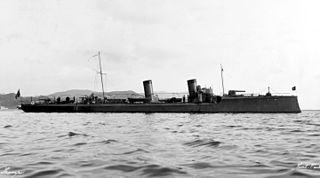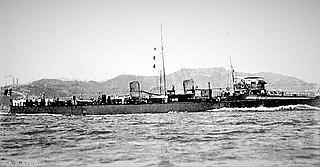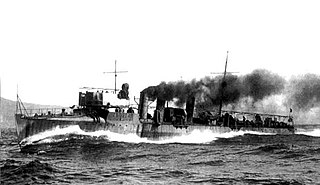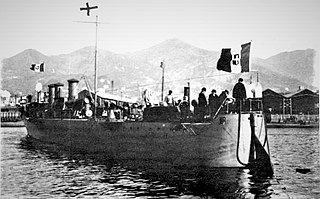
Regina Elena was the lead ship of her class of pre-dreadnought battleships built for the Italian Regia Marina. The ship was built by the La Spezia shipyard between 1901 and 1907, and was armed with a main battery of two 305 mm (12 in) guns and twelve 203 mm (8 in) guns. She was quite fast for the period, with a top speed of nearly 21 knots. Regina Elena was active in both the Italo-Turkish War with the Ottoman Empire in 1911–1912, where she participated in the Italian conquest of Cyrenaica, and World War I in 1915–1918, where she saw no action due to the threat of submarines in the narrow confines of the Adriatic Sea. She was retained for a few years after the war, but was ultimately stricken in February 1923 and broken up for scrap.

Vittorio Emanuele was an Italian pre-dreadnought battleship, laid down in 1901, launched in 1904 and completed in 1908. She was the second member of the Regina Elena class, which included three other vessels: Regina Elena, Napoli, and Roma. Vittorio Emmanuele was armed with a main battery of two 305 mm (12 in) guns and twelve 203 mm (8 in) guns. She was quite fast for the period, with a top speed of nearly 21 knots.

Roma was an Italian pre-dreadnought battleship, laid down in 1903, launched in 1907 and completed in 1908. She was the third member of the Regina Elena class, which included three other vessels: Regina Elena, Napoli, and Vittorio Emanuele. Roma was armed with a main battery of two 305 mm (12 in) guns and twelve 203 mm (8 in) guns. She was quite fast for the period, with a top speed of nearly 21 knots.

The Soldato class was a class of destroyers of the Italian Regia Marina built by Ansaldo of Genoa prior to the First World War. Ten were built for the Regia Marina between 1905 and 1910, while an eleventh ship was built for China but purchased by Italy before completion. They served during the First World War, where one was lost, with the remaining ships sold for scrap in the 1920s and early 1930s.

Puglia was a protected cruiser of the Italian Regia Marina. She was the last of six Regioni-class ships, all of which were named for regions of Italy. She was built in Taranto between October 1893 and May 1901, when she was commissioned into the fleet. The ship was equipped with a main armament of four 15 cm (5.9 in) and six 12 cm (4.7 in) guns, and she could steam at a speed of 20 knots.

The Lampo class was a class of six destroyers of the Italian Regia Marina built by the German Schichau shipyard from 1899–1901. They served in the Italo-Turkish War and the surviving ships in the First World War, before being disposed of between 1920 and 1924.

The Italian cruiser Pisa was the name ship of her class of two armored cruisers built for the Royal Italian Navy in the first decade of the 20th century. The ship participated in the Italo-Turkish War of 1911–1912, during which she supported the occupations of Tobruk, Libya and several islands in the Dodecanese and bombarded the fortifications defending the entrance to the Dardanelles. During World War I, Pisa's activities were limited by the threat of Austro-Hungarian submarines, although the ship did participate in the bombardment of Durazzo, Albania in late 1918. After the war she became a training ship and was stricken from the Navy List in 1937 before being scrapped.

Carabinere ("Carabinier") was a Soldato-class ("Soldier"-class) destroyer of the Italian Regia Marina. Commissioned in 1910, she served in the Italo-Turkish War and World War I. Reclassified as a torpedo boat in 1921, she was stricken in 1925.

Audace was the lead ship of the Audace-class destroyers of the Italian Regia Marina. Commissioned in 1914, she served during World War I, participating in the Adriatic campaign and operating as a convoy escort until she sank after a collision in 1916.

Fulmine ("Lightning") was the Kingdom of Italy′s first destroyer. Commissioned into service in the Italian Regia Marina in 1900, she served in the Italo-Turkish War and World War I. She was stricken in 1921 and scrapped.

Nembo ("Nimbus") was the lead ship of the Italian Nembo-class destroyers. Commissioned into service in the Italian Regia Marina in 1902, she served in the Italo-Turkish War and World War I. She was sunk during the latter conflict in October 1916.

Aquilone was an Italian Nembo-class destroyer. Commissioned into service in the Italian Regia Marina in 1903, she served in the Italo-Turkish War and World War I, playing an active role in the Adriatic campaign. Reclassified as a torpedo boat in 1921, she was stricken in 1923.

Alpino was a Soldato-class ("Soldier"-class) destroyer of the Italian Regia Marina. Commissioned in 1910, she served actively in the Italo-Turkish War, operating in the Ionian, Aegean, and Red Seas. During World War I she initially operated in the upper Adriatic Sea, conducting reconnaissance and minelaying operations and supporting actions by motor torpedo boats and aircraft. She subsequently operated in the southern Adriatic and the Ionian Sea, where she was assigned to escort operations and patrolling the Otranto Barrage in the Strait of Otranto. Reclassified as a torpedo boat in 1921, she was stricken in 1928.
Pontiere ("Bridgeman") was a Soldato-class ("Soldier"-class) destroyer of the Italian Regia Marina. Commissioned in 1910, she served in World War I. Reclassified as a torpedo boat in 1921, she was stricken in 1929.

Ascaro ("Askari") was a Soldato-class ("Soldier"-class) destroyer of the Italian Regia Marina. Commissioned in 1913, she served during World War I. Reclassified as a torpedo boat in 1921, she was stricken in 1930.

Garibaldino was a Soldato-class ("Soldier"-class) destroyer of the Italian Regia Marina. Commissioned in 1910, she served in the Italo-Turkish War and World War I. During the latter conflict she sank after a collision in 1918.

Artigliere was a Soldato-class ("Soldier"-class) destroyer of the Italian Regia Marina. Commissioned in 1907, she served in the Italo-Turkish War and World War I. She was stricken in 1923.
Corazziere ("Cuirassier") was a Soldato-class ("Soldier"-class) destroyer of the Italian Regia Marina. Commissioned in 1910, she served in the Italo-Turkish War and World War I. She was stricken in 1928.

Bersagliere was the lead ship of the Soldato-class ("Soldier"-class) destroyers of the Italian Regia Marina. Commissioned in 1907, she served in the Italo-Turkish War and World War I. She was stricken in 1923.
Lanciere ("Lancer") was a Soldato-class ("Soldier"-class) destroyer of the Italian Regia Marina. Commissioned in 1907, she served in the Italo-Turkish War and World War I. She was stricken in 1923.


















